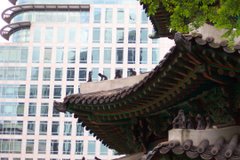The BBC has uploaded some photos from last Sunday's big birthday bash in North Korea. Included are shots of juche propaganda, sparsely cultivated land, rural villages along the pilgrimage route to Kim Il-Sung's birthplace and images from the festival that occurs every April 15th.
Although I'm sure propaganda (posters and such) seeps in through its mere presence, I believe the participatory rituals play an even greater role in inculcating a sense of national identity. The photo of the child (no more than 3 years old) dressed in a military uniform was particularly striking. The child, hardly even of speaking age, is being manipulated as a potential soldier. The idea of sacrifice for the nation is literally put upon him with this uniform before he has any notion of what the military is. The child is being socialized in the home - by his parents dressing him in the uniform, and by the community - through attending the festival. Other photos depict the Arirang games, wherein thousands of performers engage in telling the story of Korea's han - the deep pain associated with the division of the nation and hardship. (Apparently there was less of an Anti-American or militaristic emphasis to the highly choreographed performance.) The captions note that the games show (and I argue that they also create) a "unity of purpose - the suppression of the individual for the benefit of society as a whole" for performers and spectators alike. These photos provide a glimpse into the mechanisms through which North Korean patriotism is simultaneously created, codified and inculcated.
Also throughout these photos are indications of the state of North Korea. "Holiday traffic" limited to a handful of cars indicates fuel shortages and sparsely cultivated rural landscapes demonstrate potential food shortages. The decrepit village houses are a far cry from the gleaming high rises of Pyongyang. Still, the captions of the photos from the Arirang games indicate that North Koreans "believe they are the best in the world."
Although none of these images provide great new insights into North Korea (especially since Amelia already enlightened us about the flowers: Kimilsungia and Kimjongilia), they are still a valuable glimpse into the production of culture and nationalism in North Korea.
Subscribe to:
Post Comments (Atom)

No comments:
Post a Comment